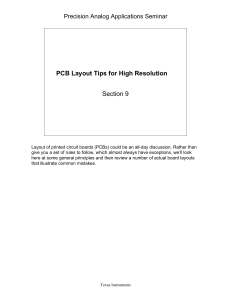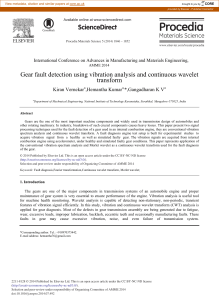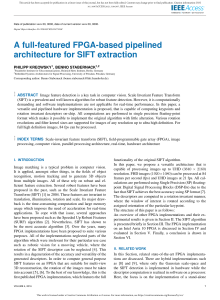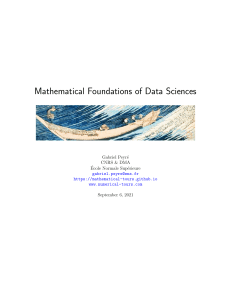2019 Chunfang Yang Locating Steganalysis of LSB Matching Based on Spatial and Wavelet Filter Fusion
реклама
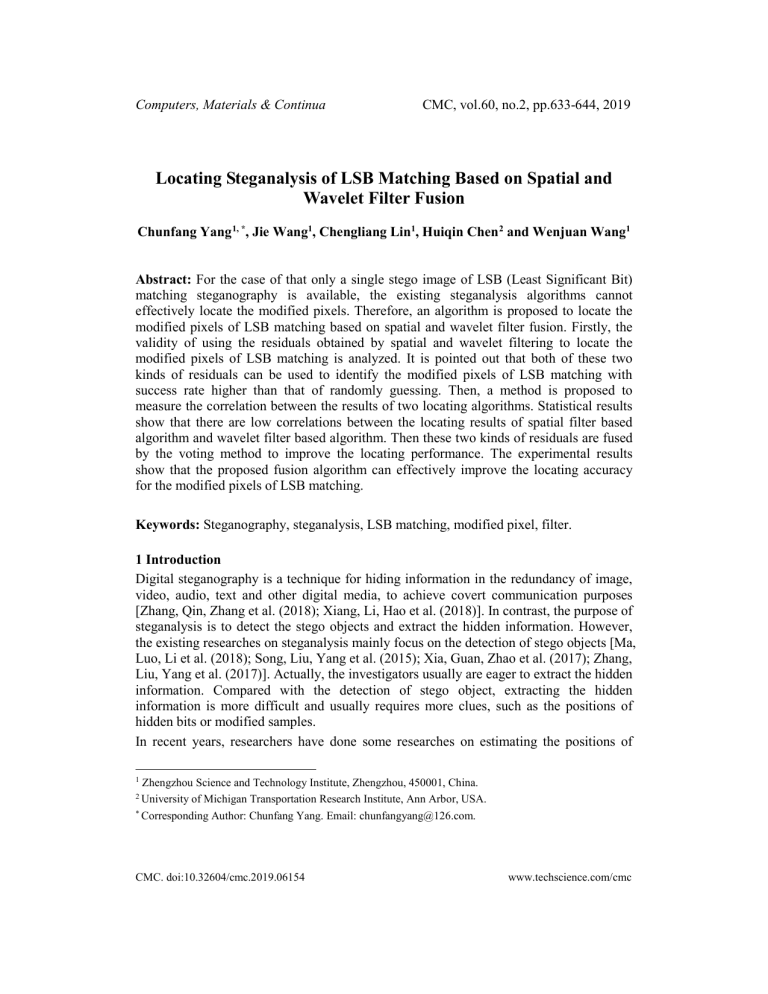
Computers, Materials & Continua
CMC, vol.60, no.2, pp.633-644, 2019
Locating Steganalysis of LSB Matching Based on Spatial and
Wavelet Filter Fusion
Chunfang Yang 1, *, Jie Wang1, Chengliang Lin1, Huiqin Chen 2 and Wenjuan Wang1
Abstract: For the case of that only a single stego image of LSB (Least Significant Bit)
matching steganography is available, the existing steganalysis algorithms cannot
effectively locate the modified pixels. Therefore, an algorithm is proposed to locate the
modified pixels of LSB matching based on spatial and wavelet filter fusion. Firstly, the
validity of using the residuals obtained by spatial and wavelet filtering to locate the
modified pixels of LSB matching is analyzed. It is pointed out that both of these two
kinds of residuals can be used to identify the modified pixels of LSB matching with
success rate higher than that of randomly guessing. Then, a method is proposed to
measure the correlation between the results of two locating algorithms. Statistical results
show that there are low correlations between the locating results of spatial filter based
algorithm and wavelet filter based algorithm. Then these two kinds of residuals are fused
by the voting method to improve the locating performance. The experimental results
show that the proposed fusion algorithm can effectively improve the locating accuracy
for the modified pixels of LSB matching.
Keywords: Steganography, steganalysis, LSB matching, modified pixel, filter.
1 Introduction
Digital steganography is a technique for hiding information in the redundancy of image,
video, audio, text and other digital media, to achieve covert communication purposes
[Zhang, Qin, Zhang et al. (2018); Xiang, Li, Hao et al. (2018)]. In contrast, the purpose of
steganalysis is to detect the stego objects and extract the hidden information. However,
the existing researches on steganalysis mainly focus on the detection of stego objects [Ma,
Luo, Li et al. (2018); Song, Liu, Yang et al. (2015); Xia, Guan, Zhao et al. (2017); Zhang,
Liu, Yang et al. (2017)]. Actually, the investigators usually are eager to extract the hidden
information. Compared with the detection of stego object, extracting the hidden
information is more difficult and usually requires more clues, such as the positions of
hidden bits or modified samples.
In recent years, researchers have done some researches on estimating the positions of
1 Zhengzhou Science and Technology Institute, Zhengzhou, 450001, China.
2 University of Michigan Transportation Research Institute, Ann Arbor, USA.
* Corresponding Author: Chunfang Yang. Email: chunfangyang@126.com.
CMC. doi:10.32604/cmc.2019.06154
www.techscience.com/cmc
634
CMC, vol.60, no.2, pp.633-644, 2019
hidden information or modified samples in stego objects. For example, for the case of
that the message bits are embedded sequentially, because LSB (Least Significant Bit)
replacement steganography would make the frequencies of two pixel values 2a and
2a + 1 ( 0 ≤ a ≤ 127 ) tend to be approximately equal, Westfeld et al. [Westfeld and
Pfitzmann (1999)] used the chi-square test to estimate the end position of the initial
sequential LSB replacement steganography where the first bit secret information is
embedded into the first sample. Ker et al. [Ker and Böhme (2008)] minimized the
weighted stego residual subsequence to estimate the starting and end positions of
sequential LSB replacement. For the case of owning multiple stego images embedded
into the same positions, Ker et al. [Ker and Böhme (2008)] located the stego pixels of
LSB replacement by accumulating weighted stego-image (WS) residuals in the same
positions of different images. Chiew et al. [Chiew and Pieprzyk (2010)] used the local
entropy to improve the algorithm proposed in Ker [Ker (2008)] when the binary image is
used as cover. Then, Ker et al. [Ker and Lubenko (2009)] filtered the horizontal, vertical
and diagonal wavelet subbands of stego images by Wiener filter, and located the stego
pixels of LSB matching by accumulating wavelet absolute residuals in the same positions
of different images. Luo et al. [Luo, Li and Yang (2011)] proposed two new residual
calculation methods by improving the WS residuals, and used them to locate the stego
pixels of LSB matching with higher accuracy than the algorithm in Ker et al. [Ker and
Lubenko (2009)]. Quach [Quach (2011, 2014a)] modeled the images by Markov model
and random field, and proposed some cover estimation algorithms based on maximum a
posteriori probability, which are applied to the locating steganalysis of LSB replacement
and LSB matching. Gui et al. [Gui, Li and Yang (2012)] used Quach’s algorithm in
Quach [Quach (2011)] to obtain eight estimated cover images from eight different
directions and used the mean of four neighborhoods to obtain the ninth estimated cover
image for each stego image, then improved the location accuracy of the algorithm in
Quach [Quach (2011)] by nine residual images between each stego image and its nine
estimated cover images. Liu et al. [Liu, Tian, Han et al. (2015)] estimated the cover
image by recompressing when the cover image has subjected JPEG compression before
LSB matching, then located the stego pixels with higher accuracy than existing
algorithms. Yang et al. [Yang, Luo, Lu et al. (2018)] proved the optimal stego subset
property of multiple least significant bits (MLSB) steganography, and proposed an
algorithm based on this property to locate the payload. For the case of owning multiple
stego images embedded message with different lengths along the same path, Quach
[Quach (2014b)] estimated the embedding path according to the residual values.
Above algorithms can accurately estimate the embedding positions of random LSB
replacement and LSB matching steganography under the condition of owning enough
stego images embedded along the same path. However, in many cases it is very difficult
for the investigators to obtain multiple stego images with the same embedding path. And
when only a stego image is available, above algorithms would locate stego positions or
modified positions with a success rate close to that of randomly guessing. Therefore, it is
still urgent to improve the locating accuracy in the case of owning a single stego image.
In 2012, Quach [Quach (2012)] proved that the modified pixels in a stego image can be
located with a lower error rate under the condition of owning enough independent non-
Locating Steganalysis of LSB Matching Based on Spatial
635
random discriminant functions. Activated by this idea, a modified pixel locating
algorithm for the typical LSB matching steganography is proposed based on fusing
spatial and wavelet filtering. This algorithm constructs discriminant functions based on
the residuals obtained by spatial and wavelet filtering respectively under the condition of
having only a single stego image, then fuses the results of two discriminant functions to
locate the modified pixels of LSB matching. The experimental results show that the
proposed algorithm can effectively improve the locating accuracy for the modified pixels
of LSB matching steganography, the advantage of true positive rate over false positive
rate is more obvious.
2 Validity analysis of spatial and wavelet filtering residuals for locating modified
pixels of LSB matching
Quach [Quach (2012)] pointed out that the prerequisites of fusing different discriminant
functions are 1) the true positive rates of these discriminant functions for the modified
pixels are higher than the false positive rate for the unmodified pixels, 2) these
discriminant functions are independent of each other. This section will analyze the
validities of spatial and wavelet filtering residuals for locating the modified pixels of LSB
matching, namely, whether the true positive rate for modified pixels is higher than the
false positive rate for unmodified pixels.
2.1 Locating modified pixels of LSB matching based on spatial residual
For the case of owning multiple stego images embedded into the same positions, the
existing locating steganalysis algorithms usually firstly estimate the cover images, then
compute the residuals between the estimated cover images and the stego images, finally
determine whether pixels in a position contain message based on the accumulated
residuals in this position of different stego images. In steganalysis, 4-neighborhood mean
filter is one of the most commonly used cover estimation algorithms.
)
)
Let X = {xi , j }(( iM, j,)N= (1,1)
denote the cover image, S = {si , j }(( iM, j,)N= (1,1)
denote the stego image of
LSB matching steganography, where M and N are the height and width of the cover and
stego images respectively. The cover image estimation algorithm based on 4neighborhood mean filter uses the mean of 4 neighborhood pixels of each pixel in the
stego image as an estimation of its cover version as follows:
1
(1)
xˆi , =
( si −1, j + si +1, j + si, j −1 + si, j +1 )
j
4
Let ni , j denote the stego noise added into the pixel xi , j by LSB matching, viz.
s=
xi , j + ni , j . Then the spatial residual can be obtained as follows:
i, j
ri , j =si , j − xˆi , j =xi , j −
1
1
xi −1, j + xi +1, j + xi , j −1 + xi , j +1 ) + ni , j − ( ni −1, j + ni +1, j + ni , j −1 + ni , j +1 )
(
4
4
Let zi , j denote the residual of stego noise in spatial domain, viz.
(2)
CMC, vol.60, no.2, pp.633-644, 2019
636
1
(3)
( ni −1, j + ni +1, j + ni, j −1 + ni, j +1 )
4
When the modification ratio of LSB matching steganography is α , the stego noise ni , j
zi , j =ni , j −
will be equal to 0, -1 and 1 with the probability P (ni , j ) as follows:
1 − α , ni , j =
0
α
P (ni , j ) = ,
ni , j = −1
2
α
ni , j = +1
2 ,
(4)
Table 1: The distribution of spatial stego noise residual in the unmodified position
( ni , j = 0 )
Spatial stego noise residual
Probability
-2
0
-1.75
0
-1.5
0
-1.25
0
-1
α 4 16
-0.75
(−α 4 + α 3 ) 2
-0.5
(7α 4 − 12α 3 + 6α 2 ) 4
-0.25
(−7α 4 + 15α 3 − 12α 2 + 4α ) 2
0
(35α 4 − 80α 3 + 72α 2 − 32α + 8) 8
0.25
(−7α 4 + 15α 3 − 12α 2 + 4α ) 2
0.5
(7α 4 − 12α 3 + 6α 2 ) 4
0.75
(−α 4 + α 3 ) 2
1
α 4 16
1.25
0
1.5
0
1.75
0
2
0
From Eq. (4), it can be deduced that when the pixel si , j did not subject modifying during
LSB matching steganography, viz. ni , j = 0 , the distribution of spatial stego noise residual
zi , j is shown in Tab. 1, where the mean is 0 and the variance is α 4 . When the pixel si , j
Locating Steganalysis of LSB Matching Based on Spatial
637
subjected modifying during LSB matching steganography, viz. ni , j = 1 or -1, the
distribution of spatial stego noise residual zi , j is shown in Tab. 2, where the mean is 0
and the variance is 1 + α 4 . The existing researches show that the difference between the
cover pixel and the mean of its 4 neighborhoods, viz. the mean of the spatial residuals of
the cover images is usually equal to 0. Therefore, it is impossible to judge whether a
pixels in the stego image has been modified according to the mean value of the spatial
residuals, but it is possible to locate the pixels modified by LSB matching steganography
according to the square of spatial residuals.
Table 2: The distribution of spatial stego noise residual in the modified position ( ni , j ≠ 0 )
Spatial stego noise residual
Probability
-2
α 4 32
-1.75
(−α 4 + α 3 ) 4
-1.5
(7α 4 − 12α 3 + 6α 2 ) 8
-1.25
(−7α 4 + 15α 3 − 12α 2 + 4α ) 4
-1
(35α 4 − 80α 3 + 72α 2 − 32α + 8) 16
-0.75
(−7α 4 + 15α 3 − 12α 2 + 4α ) 4
-0.5
(7α 4 − 12α 3 + 6α 2 ) 8
-0.25
(−α 4 + α 3 ) 4
0
α 4 16
0.25
(−α 4 + α 3 ) 4
0.5
(7α 4 − 12α 3 + 6α 2 ) 8
0.75
(−7α 4 + 15α 3 − 12α 2 + 4α ) 4
1
(35α 4 − 80α 3 + 72α 2 − 32α + 8) 16
1.25
(−7α 4 + 15α 3 − 12α 2 + 4α ) 4
1.5
(7α 4 − 12α 3 + 6α 2 ) 8
1.75
(−α 4 + α 3 ) 4
2
α 4 32
Then, 10,000 grayscale cover images of size 512×512 were obtained by randomly cutting
from 10,000 high-resolution images of “tiff” format downloaded from
http://agents.fel.cvut.cz/stegodata/RAWs/. And 1000 different pseudo-random bit streams
with length of floor (512×512×0.1) were respectively embedded into 1000 cover images
selected from the obtained 10,000 grayscale cover images by LSB matching. Fig. 1
CMC, vol.60, no.2, pp.633-644, 2019
638
shows the true positive rate for modified pixels and false positive rate for unmodified
pixels of locating algorithm based on spatial residual square. In Fig. 1, the 1000 images
were numbered in ascending order of the true positive rate to make the result more
intuitive. It can be seen that, for most images, one can use the spatial residual squares to
locate the modified pixels of LSB matching with true positive rate higher than the false
positive rate for the unmodified pixels. This satisfies one of the first prerequisite for
fusing different discriminant functions pointed out by Quach [Quach (2012)].
0.7
True Positive Rate
0.6
False Positive Rate
0.5
Rate
0.4
0.3
0.2
0.1
0
0
200
400
600
800
1000
Image No.
Figure 1: When the embedding ratio is 0.10, the performance of locating steganalysis for
LSB matching based on spatial residual square
2.2 Locating modified pixels of LSB matching based on wavelet residual
The wavelet residual was firstly introduced to steganalysis by Goljan et al. [Goljan,
Fridrich and Holotyak (2006)], and has a very good performance for detecting stego
images of LSB matching. Then, Ker et al. [Ker and Lubenko (2009)] applied it to
locating the stego positions of LSB matching for the case of owning multiple stego
images embedded into the same position. Firstly, the stego images are decomposed by
wavelet decomposition to be a low frequency subband L , a horizontal subband H , a
vertical subbands V and a diagonal subband D . Then the horizontal, vertical and
diagonal subband coefficients are filtered by a quasi-Wiener filter as follows,
σ 02W
ℜ[W ] =
σ 02 + v
(5)
where W denotes a two-dimensional signal, σ 02 denotes the stego noise variance (when
the modification ratio of LSB matching steganography is α , σ 02 = α ), vi , j represents the
local variance in the i -th row and j -th column of the cover image. In Ker et al. [Ker and
Lubenko (2009)], the local variance is estimated by MAP estimation method as follows,
=
vi , j max(0, min(vi3, j , vi5, j , vi7, j , vi9, j ) − σ 02 )
(6)
where viT, j represents the mean square of T × T adjacent samples in a square region of
size T × T centering on the i -th row and j -th column samples.
Locating Steganalysis of LSB Matching Based on Spatial
0
ℜ[ H ]
ℜ[V ]
ℜ[ D]
639
Figure 2: Wavelet residual image
After the horizontal, vertical and diagonal wavelet subband residuals ℜ[ H ] , ℜ[V ] and
ℜ[ D] are computed by (5), the wavelet residual image is constructed by combining them
with the zeroed low-frequency subband as shown in Fig. 2. Then the inverse wavelet
transform of wavelet residual image is done to generate the WAM (Wavelet Absolute
Moments) residual image R .
For the case of owning multiple stego images embedded into the same positions by LSB
matching, the algorithm in Ker et al. [Ker and Lubenko (2009)] estimates the stego
positions by the absolute means of residuals Ri , j over the same positions of these images.
When the stego images are enough, this algorithm can estimate stego positions of LSB
matching with a very low error rate. Therefore, when only a stego image of LSB
matching is available, it should be possible to determine whether a pixel has been
modified based on the absolute value of the WAM residual Ri , j with a success rate higher
than that of guessing randomly. Taking the stego images with the embedded ratio of 0.10
in previous section as an example, Fig. 3 shows the true positive rate for modified pixels
and false positive rate for unmodified pixels of LSB matching based on the absolute
values of WAM residuals computed by wavelet filtering. It can be seen that for most
images, one can use the absolute values of WAM residuals to locate the modified pixels
of LSB matching with true positive rate greater than the false positive rate. This satisfies
the first prerequisite for fusing different discriminant functions pointed out by Quach
[Quach (2012)].
0.7
True Positive Rate
0.6
False Positive Rate
Rate
0.5
0.4
0.3
0.2
0.1
0
0
200
400
600
800
1000
Image No.
Figure 3: When the embedding ratio is 0.10, the performance of locating steganalysis for
LSB matching based on wavelet residual
CMC, vol.60, no.2, pp.633-644, 2019
640
3 Locating modified pixels of LSB matching by fusing spatial and wavelet residuals
The second condition pointed out in Quach [Quach (2012)] for fusing different
discriminant functions is that different discriminant functions are independently of each
other. When the amount of modified pixels is equal to that of unmodified pixels and two
discriminant functions are independent of each other, they will have the same decision
result for about 50% of the pixels. When the discriminant functions of two discriminant
functions are exactly the same, they have the strongest correlation. Therefore, this section
adopts the following indexes to measure the correlation between the results of two
locating algorithms,
M
N
∑∑ δ ( f (i, j ), f (i, j ))
=i 1 =j 1
1
2
− 0.5
MN
(7)
0.5
where f1 (i, j ) and f 2 (i, j ) respectively denote the discriminant results of the functions
f1 and f 2 in the i -th row and j -th column, 0 indicates that the pixel is regarded as the
unmodified pixel, 1 indicates that the pixel is regarded as the modified pixel, and
ρ ( f1 , f 2 ) =
1,
0,
δ ( f1 (i, j ), f 2 (i, j )) =
f1 (i, j ) = f 2 (i, j )
f1 (i, j ) ≠ f 2 (i, j )
(8)
The stronger the independence between the results of discriminant functions f1 and f 2 is,
the value of correlation index computed by (7) will be closer to 0, and the better
performance will be reached by fusion. The weaker the independence between the results
of discriminant functions f1 and f 2 is, the value of correlation index computed by (7)
will be closer to 1, and it is more difficult to improve the performance by fusion.
1
0.8
Interdependency
0.6
0.4
0.2
0
-0.2
-0.4
0
200
400
600
800
1000
Image No.
Figure 4: Correlation between results of two locating algorithms for 1000 fully
embedded stego images
The 1000 cover images randomly selected in Section 2.1 were embedded fully by LSB
matching, so that the ratio of modified pixels in each stego image is about 50%. The
modified pixels and unmodified pixels were discriminated based on the spatial residual
and wavelet residual respectively. Then, the correlation between the results of two
Locating Steganalysis of LSB Matching Based on Spatial
641
locating algorithms was computed by (7) for each stego image.
Fig. 4 shows the correlation indexes between the locating results based on spatial residual
and the locating results based on wavelet residual for each stego image. It can be seen
that there are some correlation between the results of these two algorithms, but which are
almost lower than 0.6 and closer to 0. Therefore, fusing these two algorithm would
improve the locating accuracy for modified pixels of LSB matching.
This section will use the voting method as a fusion strategy to fuse the locating results of
above two locating algorithms, and propose the following improved locating algorithm
for LSB matching.
Algorithm 1: Locating modified pixels of LSB matching based on spatial and wavelet
filter fusion.
Input: A stego image of LSB matching, modification ratio α , discrimination threshold.
Output: An estimated modification matrix. When a pixel is discriminated as modified
pixel, the element in corresponding position of this pixel is set as 1; otherwise, the
corresponding element is set as 0.
Steps:
1) Compute the number of modified pixels, MNα , where M and N denote the width
and height of the given stego image, and α denotes the ratio of modified pixels.
2) Create a modified pixel voting matrix with size of M × N and set all elements as 0, and
create an estimated modification matrix with size of M × N and set all elements as 0.
3) According to (2), the given stego image is high-pass filtered by 4-neighborhood mean
to obtain the spatial residual image.
4) Compute the spatial residual squares, select MNα positions with the largest MNα
spatial residual squares, and set the elements in these positions of the modified pixel
voting matrix as 1.
5) Calculate a one-level wavelet decomposition of the given stego image using the 8-tap
Daubechies filter, zero out the coefficients in the low-frequency subband, and filter the
horizontal, vertical and diagonal subbands by a quasi-Wiener filtered as shown in (5).
6) Combine the zeroed low frequency subband and filtered horizontal, vertical and
diagonal subbands as the wavelet residual image.
7) Transform the wavelet residual image to the final residual image Ri , j by the inverse
wavelet transform.
8) Select MNα positions with the largest MNα absolute values of final residuals Ri , j ,
and add 1 to the elements in these positions of the modified pixel voting matrix.
9) Compare each element in the modified pixel voting matrix with the discriminant
threshold, when the value of an element is not less than the threshold, the
corresponding pixel is regarded as the modified pixel, and the corresponding element
in the estimated modification matrix is set as 1; otherwise, the corresponding pixel is
regarded as the unmodified pixel, and the corresponding element in the estimated
modification matrix is set as 0.
CMC, vol.60, no.2, pp.633-644, 2019
642
4 Experimental results and analysis
In this section, the proposed locating algorithm based on spatial and wavelet filter fusion
was used to locate the modified pixels in the 1000 stego images with embedding ratio 0.1
generated in Section 2.1.
0.7
True Positive Rate
0.6
False Positive Rate
0.5
Rate
0.4
0.3
0.2
0.1
0
0
200
400
600
800
1000
Image No.
Figure 5: Locating performance of the proposed fusion algorithm for 1000 stego images
of LSB matching with embedding ratio 0.1, when the threshold is 1
0.8
Proposed
WAM
0.6
Spatial
TPR-FPR
0.4
0.2
0
-0.2
0
200
400
600
800
1000
Image No.
Figure 6: Performance of the proposed fusion algorithm and the two original algorithms
before fusing for 1000 stego images of LSB matching with embedding ratio 0.1, when the
threshold is 1
Fig. 5 shows the true positive rate for the modified pixels and the false positive rate for
the unmodified pixels in each stego image when the threshold is 1. It can be seen that the
proposed algorithm has a higher true positive rate for the modified pixels than the false
positive rate for the unmodified pixels. This demonstrates that the proposed algorithm
can effectively locate the modified pixels, that is, can locate the modified pixels with a
success rate higher than that of guessing randomly. The difference between true positive
rate and false positive rate directly reflects the performance of the locating algorithm. The
greater difference demonstrates the better performance. Fig. 6 shows the difference
between the true positive rate for the modified pixels and the false positive rate for the
Locating Steganalysis of LSB Matching Based on Spatial
643
unmodified pixels in each stego image, which is referred as DPR (Difference between
true Positive Rate and flase Positive Rate). It can be seen from Fig. 6 that for most stego
images, the performance of the proposed fusion algorithm is better than that of the two
original algorithms before fusing.
5 Conclusion
For the case of owning a single stego image of LSB matching, the existing algorithms
cannot effectively discriminate the modified pixels and the unmodified pixels. Activated
by Quach’s idea of locating modified pixels, an improved locating algorithm for LSB
matching steganography is proposed by fusing spatial and wavelet residuals.
Experimental results show that the proposed fusion algorithm can effectively improve the
locating accuracy for the modified pixels of LSB matching.
However, because only two algorithms are fused by the simple voting method, the
accuracy is still not very satisfactory. Therefore, we would try to fuse more effective
locating algorithms by the stronger learning method [Xiang, Zhao, Li et al. (2018)].
Additionally, we may search the images with the similar contents on the Internet [Xiang,
Shen, Qin et al. (2018)], and use them as references to estimate the cover images.
Acknowledgement: This work was supported by National Natural Science Foundation of
China (Grant Nos. 61872448, 61302159, 61772549, U1804263, U1736214, 61602508)
and Science and Technology Research Project of Henan Province, China (Grant No.
152102210005).
References
Chiew, K. L.; Pieprzyk, J. (2010): Identifying steganographic payload location in binary
image. Proceedings of Pacific Rim Conference on Advances in Multimedia Information
Processing, pp. 590-600.
Goljan, M.; Fridrich, J.; Holotyak, T. (2006): New blind steganalysis and its
implications. Proceedings of SPIE 6072, Security, Steganography and Watermarking of
Multimedia Contents VIII, pp. 101-113.
Gui, X.; Li, X.; Yang, B. (2012): Improved payload location for LSB matching
steganography. Proceedings of the 19th International Conference on Image Processing,
pp. 1125-1128.
Ker, A. D.; Böhme, R. (2008): Revisiting weighted stego-image steganalysis.
Proceedings SPIE 6819, Security, Forensics, Steganography, and Watermarking of
Multimedia Contents X, pp. 1-17.
Ker, A. D. (2008): Locating steganographic payload via WS residual. Proceedings of the
10th ACM Workshop on Multimedia and Security, pp. 27-32.
Ker, A. D.; Lubenko, I. (2009): Feature reduction and payload location with WAM
steganalysis. Proceedings of SPIE 7254, Media Forensics and Security, pp. 1-13.
Liu, J.; Tian, Y.; Han, T.; Yang, C.; Liu, W. (2015): LSB steganographic payload
location for JPEG-decompressed images. Digit Signal Process, vol. 38, pp. 66-76.
644
CMC, vol.60, no.2, pp.633-644, 2019
Luo, Y.; Li, X.; Yang, B. (2011): Locating steganographic payload for LSB matching
embedding. Proceedings of International Conference on Multimedia and Expo, pp. 1-6.
Ma, Y.; Luo, X.; Li, X.; Bao, Z.; Zhang, Y. (2018): Selection of rich model steganalysis
features based on decision rough set α-positive region reduction. IEEE Transactions on
Circuits and Systems for Video Technology.
Quach, T. T. (2011): Optimal cover estimation methods and steganographic payload
location. IEEE Transactions on Information Forensics and Security, vol. 6, no. 4, pp.
1214-1222.
Quach, T. T. (2012): Locatability of modified pixels in steganographic images.
Proceedings of SPIE 8303, Media Watermarking, Security, and Forensics, pp. 1-7.
Quach, T. T. (2014a): Cover estimation and payload location using Markov random
fields. Proceedings of SPIE 9028, Electronic Imaging, Media Watermarking, Security,
and Forensics, pp. 1-9.
Quach, T. T. (2014b): Extracting hidden messages in steganographic images. Digital
Investigation, vol. 11, no. S2, pp. 40-45.
Song, X.; Liu, F.; Yang, C.; Luo, X. (2015): Steganalysis of adaptive JPEG
steganography using 2D gabor filters. Proceedings of the 3rd ACM Workshop on
Information Hiding and Multimedia Security, pp. 15-23.
Westfeld, A.; Pfitzmann, A. (1999): Attacks on steganographic systems. Proceedings of
the 3rd International Workshop on Information Hiding, pp. 61-75.
Xia, C.; Guan, Q.; Zhao, X.; Xu, Z; Ma, Y. (2017): Improving GFR steganalysis
features by using gabor symmetry and weighted histograms. Proceedings of the 5rd ACM
Workshop on Information Hiding and Multimedia Security, pp. 55-66.
Xiang, L.; Li, Y.; Hao, W.; Yang, P.; Shen, X. (2018): Reversible natural language
watermarking using synonym substitution and arithmetic coding. Computers, Materials
& Continua, vol. 55, no. 3, pp. 541-559.
Xiang, L.; Zhao, G.; Li, Q.; Hao, W.; Li, F. (2018): TUMK-ELM: a fast unsupervised
heterogeneous data learning approach. IEEE Access, vol. 6, pp. 35305-35315.
Xiang, L.; Shen, X.; Qin, J.; Hao, W. (2018): Discrete multi-graph hashing for largescale visual search. Neural Processing Letters.
Yang, C.; Luo, X.; Lu, J.; Liu, F. (2018): Extracting hidden messages of MLSB
steganography based on optimal stego subset. Science China Information Sciences, vol.
61, no. 11, pp. 1-3.
Zhang, Y.; Liu, F.; Yang, C.; Luo, X.; Song, X. et al. (2017): Steganalysis of contentadaptive JPEG steganography based on Gauss partial derivative filter bank. Journal of
Electronic Imaging, vol. 26, no. 1, pp. 1-11.
Zhang, Y.; Qin, C.; Zhang, W.; Liu, F.; Luo, X. (2018): On the fault-tolerant
performance for a class of robust image steganography. Signal Processing, vol. 146, pp.
99-111.
